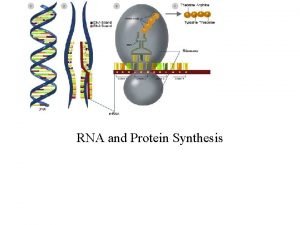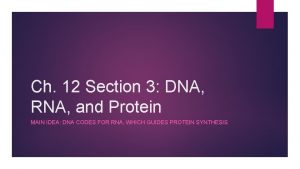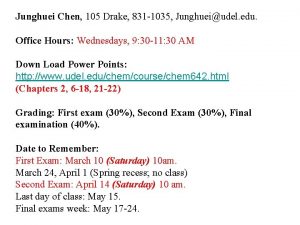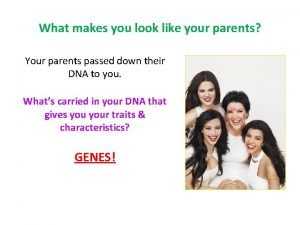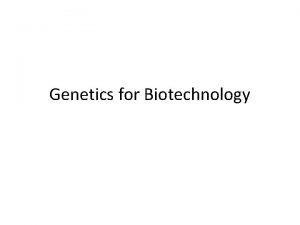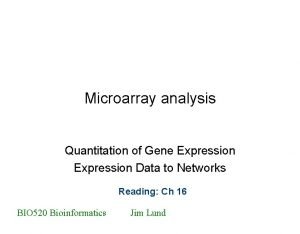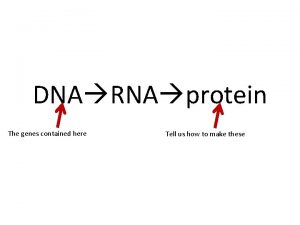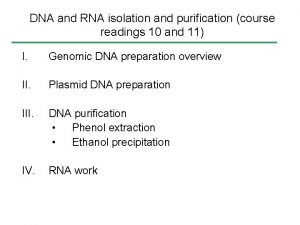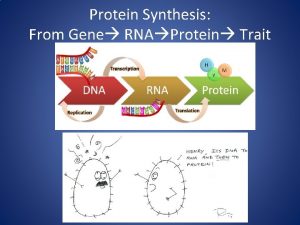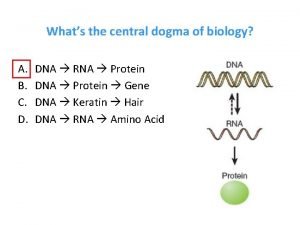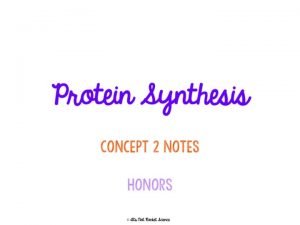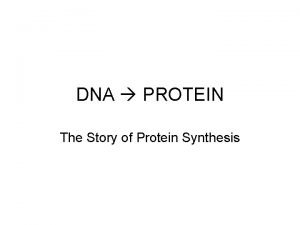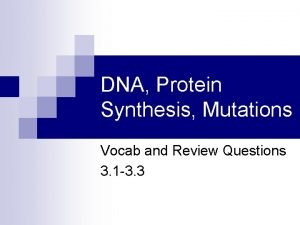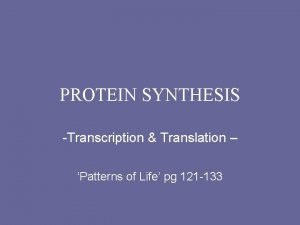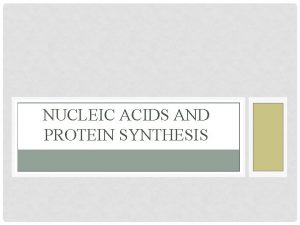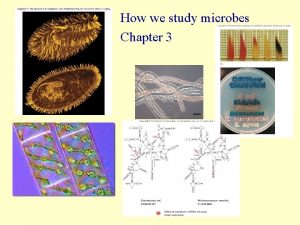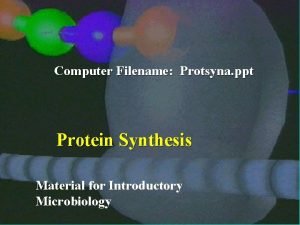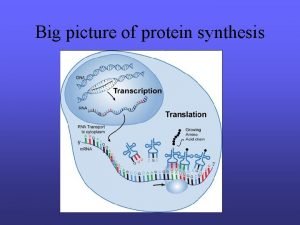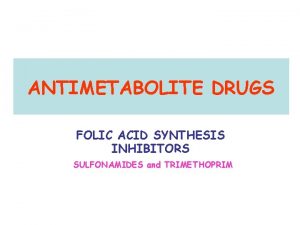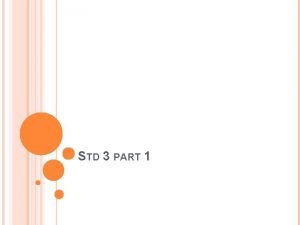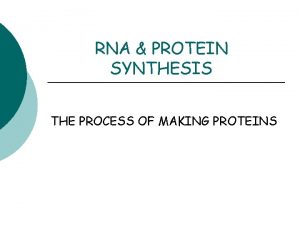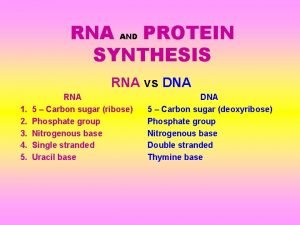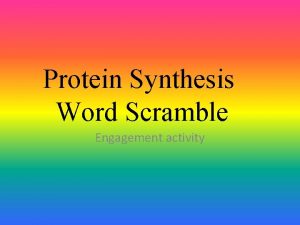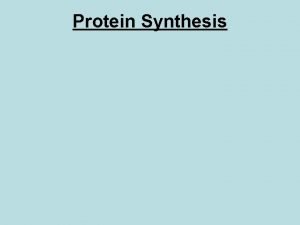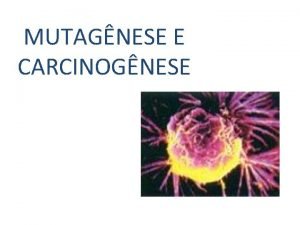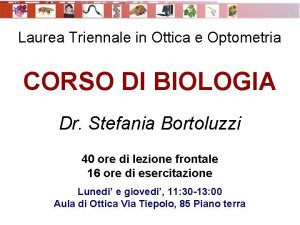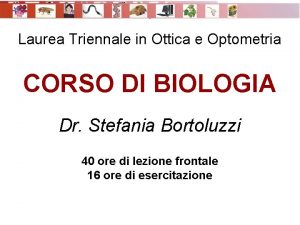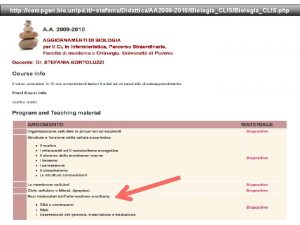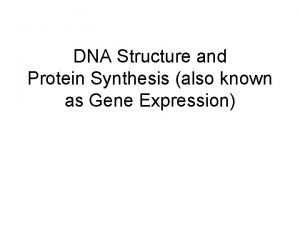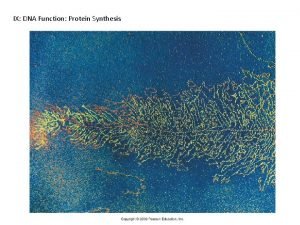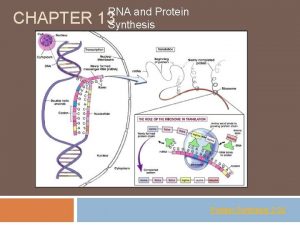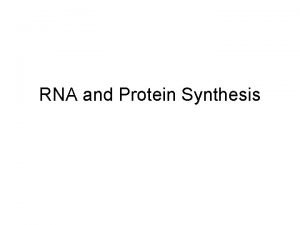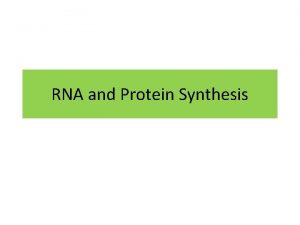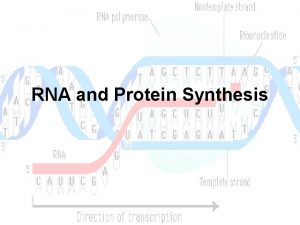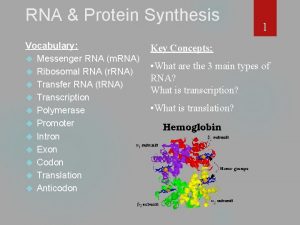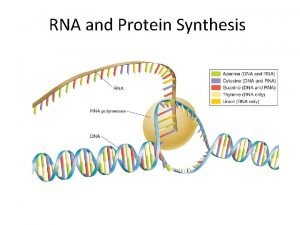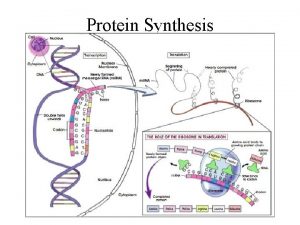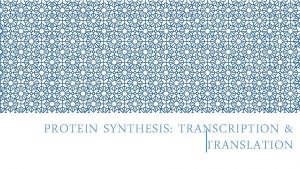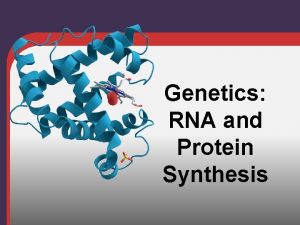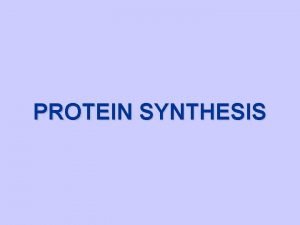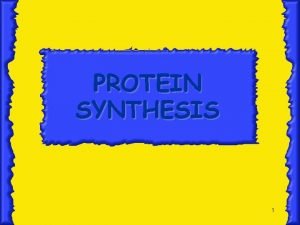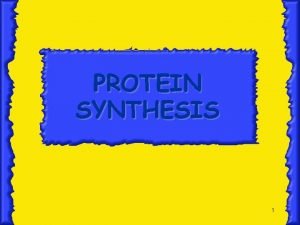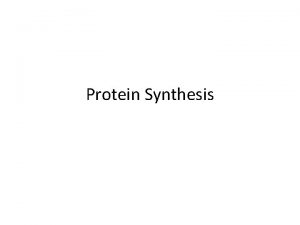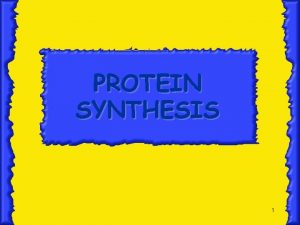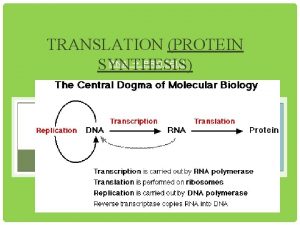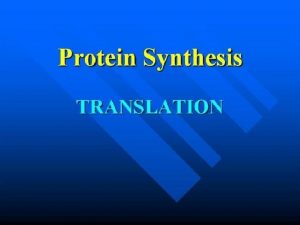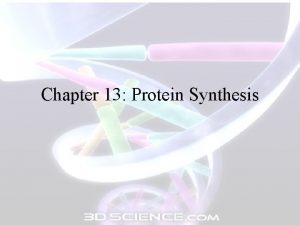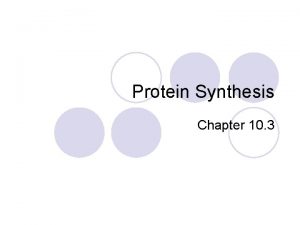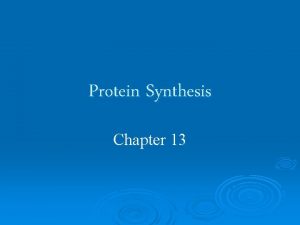RNA Chapter 13 RNA n Protein Synthesis n
















































- Slides: 48

RNA Chapter 13 RNA n. Protein Synthesis n. Pg 360 n

Central Dogma n n n DNA codes for RNA which guides protein synthesis DNA RNA Proteins Protein synthesis occurs in ALL living organisms

RNA n n n Full name: n Ribonucleic Acid Shape: n single stranded Base unit =Nucleotide n Ribose sugar n Phosphate group n Nitrogenous bases n n 4 bases: n Uracil n Adenine n Guanine n Cytosine 3 types: n m. RNA, t. RNA, r. RNA

3 differences n DNA n 1) Sugar n Deoxyribose n n 2) Bases n Adenine n Thymine n Guanine n Cytosine 3) Structure n Double helix n RNA n n 1) Sugar n Ribose 2)Bases n Adenine n URACIL n Guanine n Cytosine n 3) Structure n Single stranded

TYPE of RNA= m. RNA FUNCTION • Carries instructions from DNA to make proteins

nd 2 n type = r. RNA Helps to form ribosomes in the cytoplasm

3 rd type= t. RNA Transfers amino acids to the ribosome n Has 2 parts n Amino acid n Anticodon n

The 3 types of RNA

Protein Synthesis n Occurs in 2 steps: n Transcription n Translation

Let’s watch before we begin

TRANSCRIPTION n n n Segments of DNA serve as templates to produce complementary m. RNA molecules DNA template is complementary to the RNA This occurs in the cytoplasm of prokaryotes This occurs in the nucleus of eukaryotes Need the enzyme RNA polymerase

Transcription

Transcription n RNA polymerase This binds to DNA n Unwinds the DNA n Uses DNA as a template to make RNA n n Example: DNA=TACGGGAGCCCUAACUG m. RNA=

How do you start & stop? n n n The enzyme RNA polymerase binds to specific sequences on the DNA called promoters There are portions of DNA that DO NOT code for anything (non-sense) = INTRONS The actual coding sequence is called EXONS

Transcription Animation click on picture

DNA RNA Practice n If the original DNA strand is: n TAC TTA n What will the strand be at the end of transcription? n AUG AAU GGG UAC CUU UAA n This occurs in the cytoplasm of prokaryotes and in the nucleus of eukaryotes RNA is bonded by covalent bonds n CCC ATG GAA ATT

The Code n We need to figure out the code so that we can make an amino acid sequence n So far we had DNA in the language of nucleotides make RNA in the language of nucleotides in the process of transcription but how do we get from nucleotide language to protein language? ? ?

The Code n n n So we need a “dictionary” to find this genetic code We need to find the “Coded Language” to make proteins We read it 3 letters at a time

Coded language n Each 3 letter word corresponds to a specific amino acid n n n This 3 letter word is called a CODON Found on m. RNA Corresponds to a particular amino acid

n How do Read Codons? Well…. We need the Codon Genetic Code Wheel There are 2 types that we will go over

1) Start with the base in the middle 3) Outermost ring for the 3 rd base 2) Move to 2 nd ring for 2 nd base


Practice n n Here is the codon n n n n UUU UAA AUG AGU CGA CCC UCA AAG What is the corresponding amino acid? n n n n Phenylalanine Stop Start or methionine Serine Arginine Proline Serine Lysine

Practice n m. RNA’s codons n AUG n AAU n GGG n UAU n UAA n t. RNA’s anticodons n UAC n UUA n CCC n AUA n AUU

Journals n Protein Synthesis (pg 96/97) n n Identify the structures labeled A- J Complete the transcription part of the cookie journal (pg 99)

So…. What’s next? n n Let’s complete the second step which is called…. ? ? Don’t forget to paste your steps next to your cookie cooking steps

Quick Review

Translation n nd (2 step) The sequence of nucleotides bases on a m. RNA molecule is a set of instructions that give the order for amino acids should be joined to produce polypeptides (AKA proteins)

Translation steps n n n After transcription, m. RNA leaves the nucleus and enters the cytoplasm Ribosome attaches to the m. RNA Codons pass thru the ribosome as the codon is read

Translation n n t. RNA will bring in the proper amino acids into the ribosome The t. RNA matches its anticodon to the codon on the m. RNA = complementary t. RNA brings in corresponding the amino acid t. RNA leaves the amino acid behind as another t. RNA enters

Translation n n This continues until the entire “code” is read This creates a protein Ceases when a STOP codon is reached The protein goes off and does its job


Animation of Translation

Protein Synthesis watch animations

Central Dogma n Information is transferred from: DNA RNA makes proteins

Let’s go thru the Process DNA m. RNA t. RNA Amino Acid TAC AUG UAC Methionine (Start)

How are Proteins made? Pg 100 Gene A Gene B Gene D GAT DNA m. RNA Codon Anticod on Amino Acid Gene C UAU UUC Tryptophan

Movie on lac operon Are we on target!!

Mutations n n Heritable changes in genetic info 2 types 1) GENE MUTATIONS 2) CHROMOSOME MUTATIONS

Gene Mutations n Point mutations n n Change in 1 or a few nucleotides SUBSTITUTION One based changed for another n CCC CCA n n How did this change? Proline CCC ACC n n How did this change Proline threonine

Gene Mutations n Frameshift Mutation: entire message shifted and all amino acids changed n Deletion (1 is deleted) AUG CCC UGA n AUC CCU GA n n Insertion (1 base inserted) AUG CCC UGA n AUG GGC CUG A n

Chromosome Mutation n Change in number or structure of chromosomes n n Deletion Duplication Inversion Translocation

DELETION INSERTION SUBSTITUTION

Effects of Mutations n Errors in DNA replication n 1 in 10 million Environmental conditions Mutagen n Agent that can cause mutations

Effects can vary n n No effect Beneficial n n Produce new functions Ability to adapt/evolve Increase resistance Harmful n Lead to disease/cancer

Polyploidy n Having extra sets of chromosomes n 3 or 4 sets of chromosomes

Body Cell vs. Sex Cell n n Occurs in somatic cells Will not be passed on to the next generation Sickle cell worksheet • Chromosome are affect • Will impact the offspring • Will be passed on from generation to generation

Journals n n n Mutations & worksheet Cookie Journal (pg 99) Complete Protein Synthesis labels (pg 97)
 Totipotent cells
Totipotent cells Section 12 3 rna and protein synthesis
Section 12 3 rna and protein synthesis Order of bases in dna
Order of bases in dna Dna protein synthesis study guide answers
Dna protein synthesis study guide answers Dna and genes chapter 11
Dna and genes chapter 11 Section 12 3 rna and protein synthesis
Section 12 3 rna and protein synthesis Chapter 12 section 3 dna rna and protein
Chapter 12 section 3 dna rna and protein Synthesis of rna
Synthesis of rna Dna rna protein central dogma
Dna rna protein central dogma Dna rna protein central dogma
Dna rna protein central dogma Dna rna protein
Dna rna protein Dna rna protein
Dna rna protein Dna rna protein diagram
Dna rna protein diagram Protein
Protein Cell analogy restaurant
Cell analogy restaurant Transcription and translation
Transcription and translation Transcription and translation bbc bitesize
Transcription and translation bbc bitesize Missense mutation in sickle cell anemia
Missense mutation in sickle cell anemia Protein synthesis cookie analogy
Protein synthesis cookie analogy Whats translation in biology
Whats translation in biology Rna types
Rna types Protein synthesis
Protein synthesis Protein synthesis
Protein synthesis Protein synthesis and mutations
Protein synthesis and mutations Synthesis
Synthesis Protein synthesis and mutations
Protein synthesis and mutations Protein synthesis animation mcgraw hill
Protein synthesis animation mcgraw hill Molecular genetics
Molecular genetics Translate
Translate Ribonucleic acid
Ribonucleic acid Riosome
Riosome Protein synthesis ppt
Protein synthesis ppt Picture of protein synthesis
Picture of protein synthesis Methoteraxate
Methoteraxate Which best summarizes the process of protein synthesis?
Which best summarizes the process of protein synthesis? Concept map of protein synthesis
Concept map of protein synthesis Protein synthesis
Protein synthesis Protein synthesis scramble
Protein synthesis scramble Protein synthesis
Protein synthesis Cytosio
Cytosio Protein synthesis
Protein synthesis Protein synthesis
Protein synthesis Protein synthesis
Protein synthesis Protein synthesis
Protein synthesis Protein synthesis
Protein synthesis Catalytic functions
Catalytic functions Rna dna venn diagram
Rna dna venn diagram Channel vs carrier proteins
Channel vs carrier proteins Protein-protein docking
Protein-protein docking





